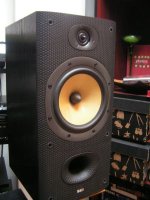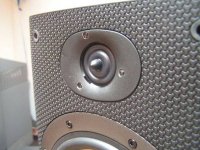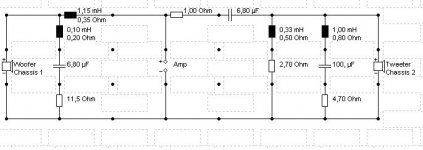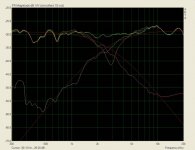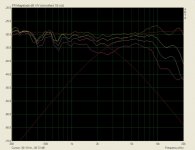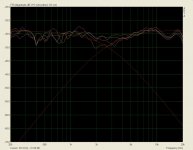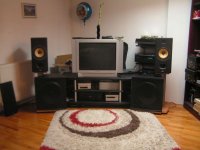B&W saga continued
Hi
I managed to get things a (big) step further, inspired by the great and well-known Zaph ZD5 design and helped by more decent measurement technique (calibrated mic + Arta software). I EXCHANGED the original tweeters to Vifa XT25s and I truly am very pleased with the results.
Idea and motivation After upgrading my measurement equipment, things looked a bit different with the phase-plug-modded B&W woofers. They have an earlier and smoother roll-off, as it has been already pointed here. The roll-off curve ((with the original series inductor) is quite close to an acoustic LR2 response around 2700Hz. As I have seen Zaph ZD5, I knew that there is a good opportunity for a meaningful upgrade to LR2 Vifa XT25, as the original B&W tweeters would never go down that low (Fs aroung 1400 Hz)!
Note:while my first thought - as well as other people's here - was to use part of Zaph's crossover desing "as is", this turned out to be impossible - as Zaph and other people have pointed out. Rather, extensive modifications of the crossover were required, as I will show later on.
Physical tweeter mounting I had luck. The original B&W tweeters are mounted from behind on the plastic part of the baffle (which is in turn screwed onto a second cardboard baffle). I removed the original flanges of the Vifas and screwed them directly onto the baffle, as it can be seen in pictures. While the resulted WG is not identical to the original, it is close and I have reason to think that the influence on response is not that big. I do however have a small problem with the remaining space between tweeters plate and baffle, I think I would use some felt there.
Crossover This is, of course, inspired from Zaph's. A first difference is made by the fact that the B&W woofer is (much) more sensitive, around 90 dB. Now the original crossover is design for the ~85 dB of the Revelator woofer and turned out not to work in my case. I had to redesign (see schematics).
I kept the conjugate notch, as this is tweeter's own. After some testing, I came up with a 6.8 uF series capacitor and a 2.7 ohm/0.33mH shaping group. Luckily - and this is a big difference - it looks like I can get rid of the lattice network, as I managed to get acceptable phase without it. Not that I would have a problem using a lattice network: it COULD actually improve things a bit (see reverse null), but at this time I don't know if the improvement is worth it.
There is also a light notch on the woofer to get closer to the LR2 curve. The crossover point is around 2700 Hz.
Measurements were performed in the original box/baffle, using a pseudo-calibrated mic and Arta software with pink noise. I did not managed yet to make some more anechoic measurements (my room was small) and I think this is why the response is ragged in the low end - so feel free to criticise me, I am by no means an expert.
Now, while the response is not perfect, I consider it acceptable. As in Zaph design, the top octaves are tilted up to compensate for off-axis roll-off. Both horizontal and vertical response seem OK (the vertical is symetric, as the two botton curves show, they were taken at about + and - 15 degrees)
The reverse null is not great, but it's there and symmetrical.
Hi
I managed to get things a (big) step further, inspired by the great and well-known Zaph ZD5 design and helped by more decent measurement technique (calibrated mic + Arta software). I EXCHANGED the original tweeters to Vifa XT25s and I truly am very pleased with the results.
Idea and motivation After upgrading my measurement equipment, things looked a bit different with the phase-plug-modded B&W woofers. They have an earlier and smoother roll-off, as it has been already pointed here. The roll-off curve ((with the original series inductor) is quite close to an acoustic LR2 response around 2700Hz. As I have seen Zaph ZD5, I knew that there is a good opportunity for a meaningful upgrade to LR2 Vifa XT25, as the original B&W tweeters would never go down that low (Fs aroung 1400 Hz)!
Note:while my first thought - as well as other people's here - was to use part of Zaph's crossover desing "as is", this turned out to be impossible - as Zaph and other people have pointed out. Rather, extensive modifications of the crossover were required, as I will show later on.
Physical tweeter mounting I had luck. The original B&W tweeters are mounted from behind on the plastic part of the baffle (which is in turn screwed onto a second cardboard baffle). I removed the original flanges of the Vifas and screwed them directly onto the baffle, as it can be seen in pictures. While the resulted WG is not identical to the original, it is close and I have reason to think that the influence on response is not that big. I do however have a small problem with the remaining space between tweeters plate and baffle, I think I would use some felt there.
Crossover This is, of course, inspired from Zaph's. A first difference is made by the fact that the B&W woofer is (much) more sensitive, around 90 dB. Now the original crossover is design for the ~85 dB of the Revelator woofer and turned out not to work in my case. I had to redesign (see schematics).
I kept the conjugate notch, as this is tweeter's own. After some testing, I came up with a 6.8 uF series capacitor and a 2.7 ohm/0.33mH shaping group. Luckily - and this is a big difference - it looks like I can get rid of the lattice network, as I managed to get acceptable phase without it. Not that I would have a problem using a lattice network: it COULD actually improve things a bit (see reverse null), but at this time I don't know if the improvement is worth it.
There is also a light notch on the woofer to get closer to the LR2 curve. The crossover point is around 2700 Hz.
Measurements were performed in the original box/baffle, using a pseudo-calibrated mic and Arta software with pink noise. I did not managed yet to make some more anechoic measurements (my room was small) and I think this is why the response is ragged in the low end - so feel free to criticise me, I am by no means an expert.
Now, while the response is not perfect, I consider it acceptable. As in Zaph design, the top octaves are tilted up to compensate for off-axis roll-off. Both horizontal and vertical response seem OK (the vertical is symetric, as the two botton curves show, they were taken at about + and - 15 degrees)
The reverse null is not great, but it's there and symmetrical.
Attachments
Individual driver response, sum and reverse null. In the meantime, I increased the tweeter series resistor from 1 to 1.5 ohm, as the tweeter level was a bit fatiguing in my room. As in the original Zaph design, modifying the series resistor does not mess up things in the crossover area.
Attachments
For now, I will stop here and not make any statements about the sound, except that I am very pleased and that the difference to the previous sound ist obvious. I still have to do some fine-tuning after longer listening sessions.
I would appreciate any comments, critique, suggestions, etc. Feel free !
I would appreciate any comments, critique, suggestions, etc. Feel free !
bzfcocon said:Indeed, the reverse null was measured on tweeter axis. And yes, you are probably right, slightly below that - which also happens to be the natural listening position - things might get phase-better.
Regarding the depth of the null, remember that you see a 3rd octave graph here. The notch is getting smoothed also. Must be nulling better in reality than it shows. 12dB symmetric in a 3rd octave graph is no slouch in my book. And maybe its not the best null point as you wrote above. Good work.
No. Filters are first(and a half) order and the introduced phase shift fits the physical acoustic center mismatch with the tweeter in the same polarity as the woofer.happy.gringo said:The crossover diagram shows the polarity as the same for the woofer and tweeter. Shouldn't the tweeter be reversed?
You're right, that was a speculation. And yes, the 1/6th or 1/9th octave graph does show a deeper null, but the difference is not that big.salas said:
Regarding the depth of the null, remember that you see a 3rd octave graph here. The notch is getting smoothed also. Must be nulling better in reality than it shows. 12dB symmetric in a 3rd octave graph is no slouch in my book. And maybe its not the best null point as you wrote above. Good work.
Anyway, I was curious if there are any guidelines w.r.t. audibility of a perfect reverse null. Is the absolute phase coherence a goal that one should achieve at any price - or is it better to stop at a "sane" number of shaping components, that is, less than perfect but still acceptable ?
salas said:Good idea, nice results and descriptions to us. How is it sounding?
I am not good at such descriptions, but I will give a try.
First, a few words on my setup. Althoung I am sure I could use the speakers fullrange with decent performance, I don't. They are crossed over at 160 hz with stereo Y-Dipole bass units featuring 15" drivers (see picture below). The crossover is LR4 active, also DIY.
At this point, I must say that the B&W woofers are not bad units - on the contrary, they are very well built - but one can also see compromises. They lack distortion reduction mechanisms employed in expensive high-end units. However, I have found out that not forcing them to reproduce the bottom end GREATLY improve their performance! If the excursion is reduced, so is distortion. The audible effect is quite impressive ! So, I get the bass from dipoles and let the main speakers play the part where they can perform best.
The B&Ws (if I still can call them that) now play in another league. Transparency, dynamics and naturalness, it's all there now. The new tweeter spreads a nice wide soundstage and the overall musical experience is very enjoyable. I am not a detail addict, but the sound IS quite detailed without getting fatiguing.
However, I am not completely satisfied. There is still some "boxiness" left and, although I do not believe that dipoles are the universal solution, I will give it a try soon. At least in theory, having a more uniform off axis roll-off (the bass units are already dipoles !) should result in a more natural and transparent sound.
This turns out to be an easy experimet to do: the front baffle with drivers is removable. I plan to keep the same crossover and add a shelving low pass filter in the active crossover to equalize the dipole. Some experimentation is required w.r.t the actual baffle.
Attachments
bzfcocon said:You're right, that was a speculation. And yes, the 1/6th or 1/9th octave graph does show a deeper null, but the difference is not that big.Anyway, I was curious if there are any guidelines w.r.t. audibility of a perfect reverse null. Is the absolute phase coherence a goal that one should achieve at any price - or is it better to stop at a "sane" number of shaping components, that is, less than perfect but still acceptable ?
Use the less smoothing available for that. 1/24 for ARTA. It is going to be maybe 6dB better than in 1/3. Normally when measuring, you can not track the simulated null as deep. It takes absolute precision in placement and IMHO there is no point doing it. If you see centered and smoothly symmetric nulling clearly depicted, its tell tale of good phase tracking. If I see -15dB to - 20dB in a 1/24 graph I am very happy.
No. Filters are first(and a half) order and the introduced phase shift fits the physical acoustic center mismatch with the tweeter in the same polarity as the woofer.
You're right, that was a speculation. And yes, the 1/6th or 1/9th octave graph does show a deeper null, but the difference is not that big.
Anyway, I was curious if there are any guidelines w.r.t. audibility of a perfect reverse null. Is the absolute phase coherence a goal that one should achieve at any price - or is it better to stop at a "sane" number of shaping components, that is, less than perfect but still acceptabl
I am not good at such descriptions, but I will give a try.
First, a few words on my setup. Althoung I am sure I could use the speakers fullrange with decent performance, I don't. They are crossed over at 160 hz with stereo Y-Dipole bass units featuring 15" drivers (see picture below). The crossover is LR4 active, also DIY.
At this point, I must say that the B&W woofers are not bad units - on the contrary, they are very well built - but one can also see compromises. They lack distortion reduction mechanisms employed in expensive high-end units. However, I have found out that not forcing them to reproduce the bottom end GREATLY improve their performance! If the excursion is reduced, so is distortion. The audible effect is quite impressive ! So, I get the bass from dipoles and let the main speakers play the part where they can perform best.
The B&Ws (if I still can call them that) now play in another league. Transparency, dynamics and naturalness, it's all there now. The new tweeter spreads a nice wide soundstage and the overall musical experience is very enjoyable. I am not a detail addict, but the sound IS quite detailed without getting fatiguing.
However, I am not completely satisfied. There is still some "boxiness" left and, although I do not believe that dipoles are the universal solution, I will give it a try soon. At least in theory, having a more uniform off axis roll-off (the bass units are already dipoles !) should result in a more natural and transparent sound.
This turns out to be an easy experimet to do: the front baffle with drivers is removable. I plan to keep the same crossover and add a shelving low pass filter in the active crossover to equalize the dipole. Some experimentation is required w.r.t the actual baffle.
did you upgrade the caps at all.??
Hello,
I am new to this forum and I have to thank bzfcocon for this topic!! I have purchased a damaged pair of 602 S3 just recently. The surrounds were completely stiff and needed to be replaced and on one of the drivers the dust cap was also damaged. Since it was impossible to get spare dust caps for these drivers, I luckily came across this thread and decided to make phase plugs. I made them out of beech wood and decided to leave them looking as natural as possible. I think they look really great and of course they sound amazing. I don't have reference of before/after, I can only compare them to 600 S3. I will also do some reinforcement of the cabinets in the future like in the first post, but generally this is not needed since some vibration can be heard only when volume is really high up.
Because I also needed to replace the surrounds, removing the dust-caps was very helpful for that. So this is also one big plus of phase plugs. If I will need to replace dust caps on any other I will definitely go this way and make phase plugs instead of replacing dust caps.
I am new to this forum and I have to thank bzfcocon for this topic!! I have purchased a damaged pair of 602 S3 just recently. The surrounds were completely stiff and needed to be replaced and on one of the drivers the dust cap was also damaged. Since it was impossible to get spare dust caps for these drivers, I luckily came across this thread and decided to make phase plugs. I made them out of beech wood and decided to leave them looking as natural as possible. I think they look really great and of course they sound amazing. I don't have reference of before/after, I can only compare them to 600 S3. I will also do some reinforcement of the cabinets in the future like in the first post, but generally this is not needed since some vibration can be heard only when volume is really high up.
Because I also needed to replace the surrounds, removing the dust-caps was very helpful for that. So this is also one big plus of phase plugs. If I will need to replace dust caps on any other I will definitely go this way and make phase plugs instead of replacing dust caps.
Attachments
-
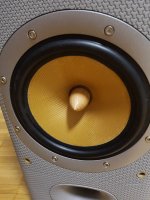 20170828_220431.jpg636.8 KB · Views: 97
20170828_220431.jpg636.8 KB · Views: 97 -
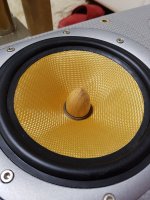 20170828_220455.jpg733.2 KB · Views: 99
20170828_220455.jpg733.2 KB · Views: 99 -
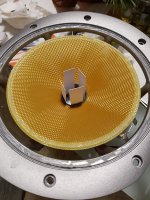 20170828_205421.jpg866 KB · Views: 105
20170828_205421.jpg866 KB · Views: 105 -
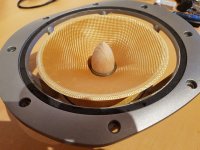 20170827_161956.jpg656.5 KB · Views: 89
20170827_161956.jpg656.5 KB · Views: 89 -
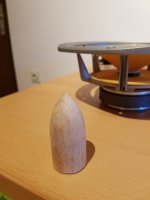 20170827_161926.jpg332.4 KB · Views: 142
20170827_161926.jpg332.4 KB · Views: 142 -
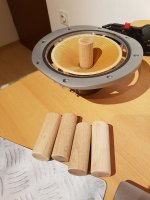 20170826_214758.jpg625.2 KB · Views: 140
20170826_214758.jpg625.2 KB · Views: 140 -
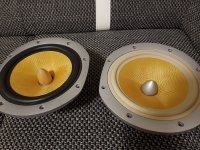 20170828_203418.jpg897.8 KB · Views: 146
20170828_203418.jpg897.8 KB · Views: 146 -
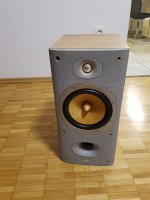 20170828_220437.jpg596.3 KB · Views: 152
20170828_220437.jpg596.3 KB · Views: 152 -
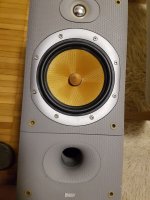 20170828_220411.jpg640 KB · Views: 93
20170828_220411.jpg640 KB · Views: 93
- Status
- This old topic is closed. If you want to reopen this topic, contact a moderator using the "Report Post" button.
- Home
- Loudspeakers
- Multi-Way
- B&W 602 S3 mods
